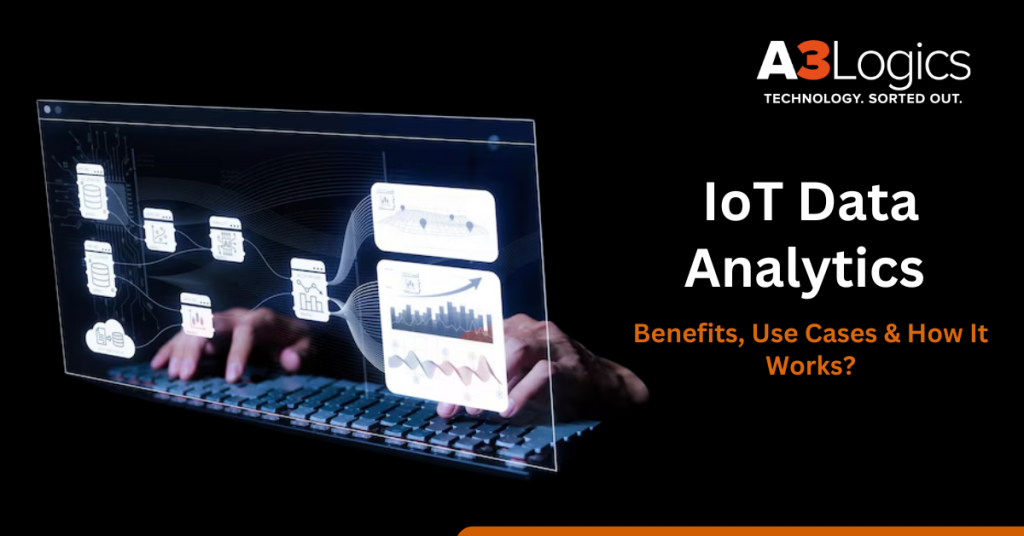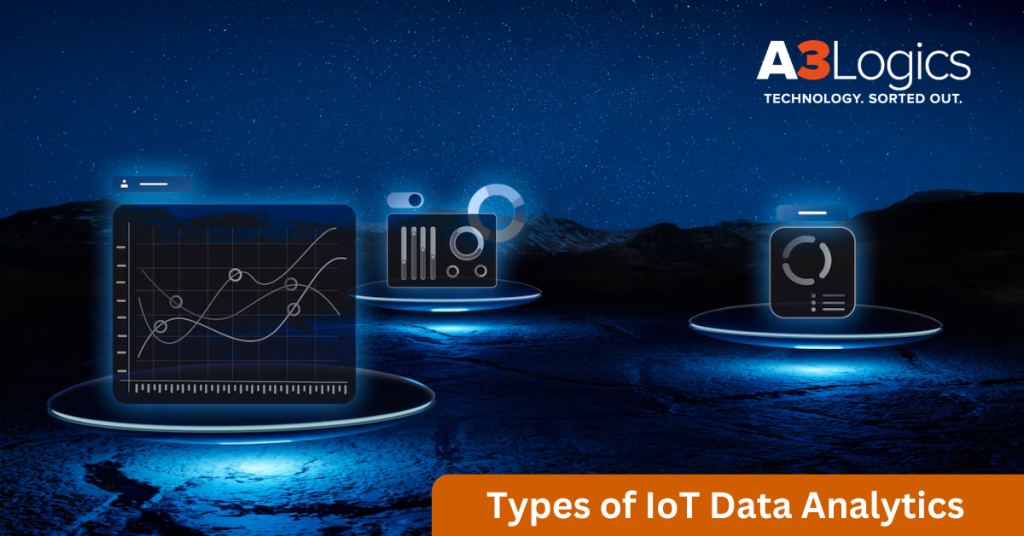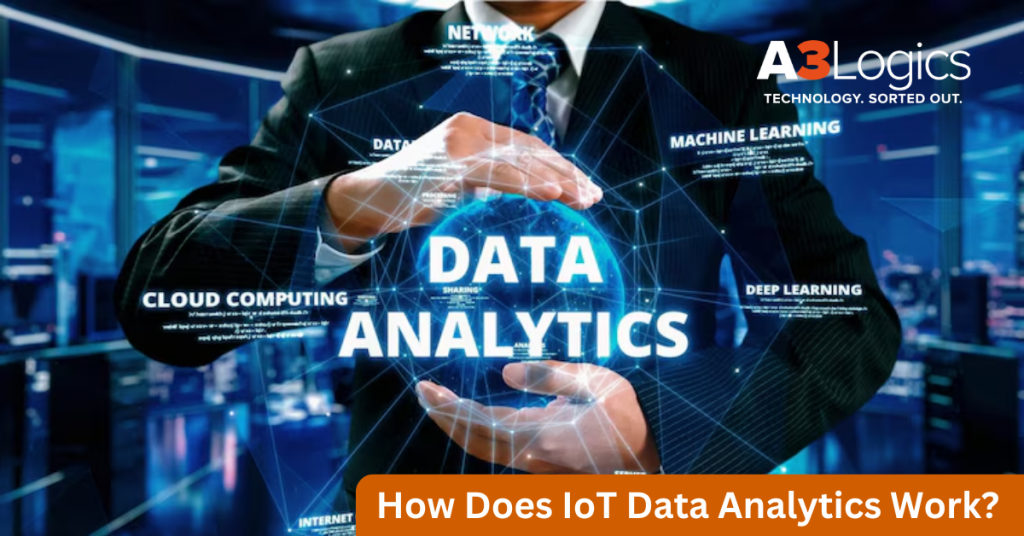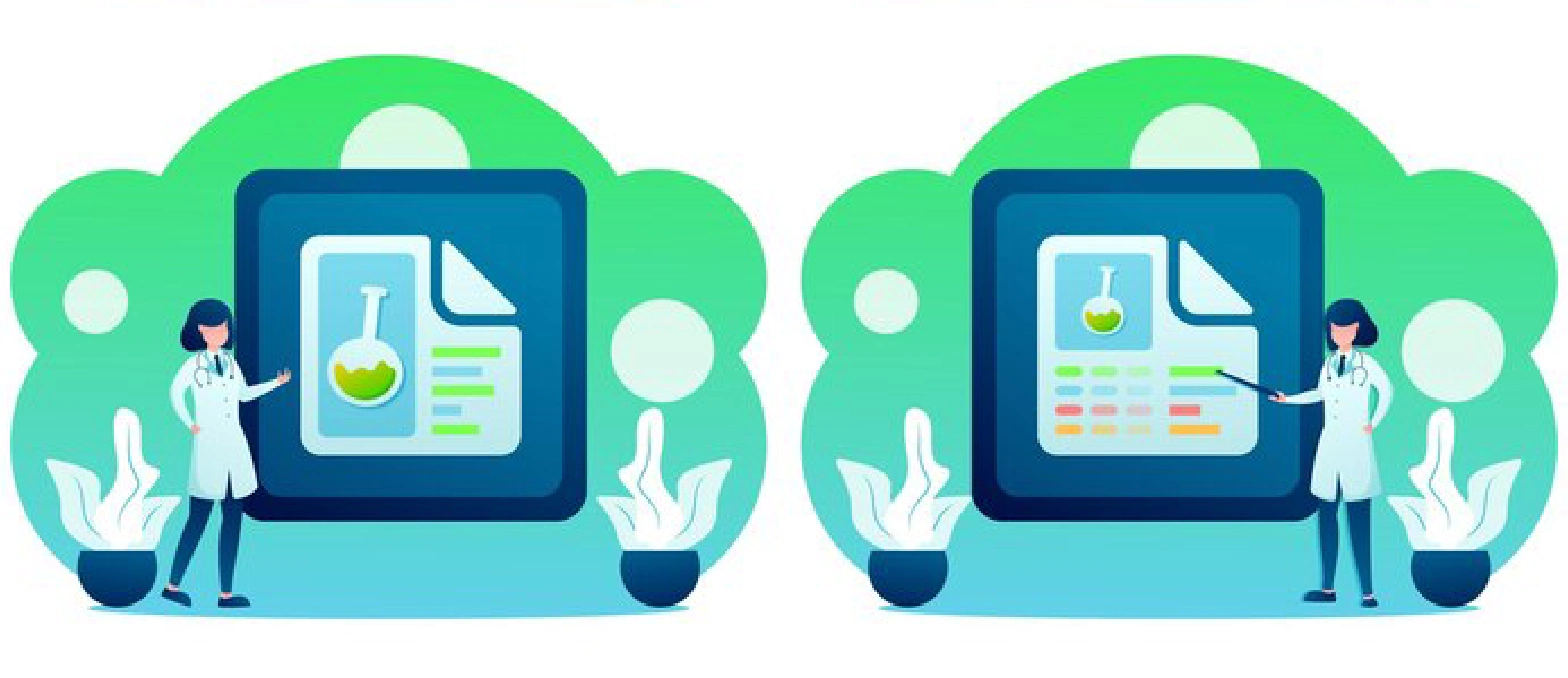IoT Data Analytics: Data is not valuable until it is properly recorded, processed, and analyzed. Until recently, companies had to devote significant time and money to developing and deploying data-crunching technologies. The Internet of Things (IoT) and data are inherently intertwined, thus ubiquitous data consumption and production will continue to develop at a rapid pace.
IoT-based applications are employed in a variety of industries due to the interconnection of several devices, networks, and technologies. As a result, most businesses struggle to manage and understand the massive amounts of data that are consumed and generated at an exponential rate. This large influx of data is driving broad use of IoT data analytics systems.
If you are curious to learn more about IoT data analytics in this blog we have taken a deep dive into what is IoT data analytics. We have also taken a look at the IoT data analytics use cases, benefits of IoT data analytics, its types and how it works.
Table of Contents
What is IoT Data Analytics?

IoT data analytics, often known as IoT analytics, is the process of analyzing data generated and collected by IoT devices using a specific set of data analytics tools and techniques. The IoT analytics market is expected to grow from a valuation of USD 17.14 billion in 2020 to USD 81.67 billion by 2026 with a CAGR of 29.8% during the forecast period.
The actual purpose of IoT data analytics is to convert enormous amounts of unstructured data from various devices and sensors throughout the heterogeneous Internet of Things ecosystem into meaningful and actionable insights to drive smart business choices and further data analysis.
Furthermore, IoT analytics enables the identification of patterns in data sets, both current and historical, which may subsequently be utilized to make predictions and modifications to future events.
Types of IoT Data Analytics

Implementing IoT data analytics in your business process can help in improving functions and boost customer satisfaction. However, finding the right types of IoT data analytics solutions that go with your business needs is also important.
In this section we have taken a deep dive into the various types of IoT Data Analytics that will make it easier for you to find the right one!
1. Descriptive Analytics
Descriptive analytics is concerned with summarizing past IoT data to respond to the question: What happened? It is about structuring and visualizing sensor readings, device logs, and operational metrics to give a clear view of past behaviors and conditions. Methods such as dashboards, reports, and simple statistical analysis are employed to enable organizations to understand trends, usage patterns, and anomalies in their IoT environments.
2. Diagnostic Analytics
Diagnostic analytics explores IoT data further to find out why things happened in the first place, answering: Why did it happen? By correlating data from multiple IoT sources—such as device failure reports, environmental conditions, and user behavior—it finds root causes and contributing factors. Such insight assists businesses and operators in troubleshooting problems more quickly and preventing future events.
3. Predictive Analytics
IoT Predictive Analytics applies past IoT data along with machine learning models to predict the future: What will probably happen? For instance, it might forecast equipment malfunction, energy spike, or road congestion by learning patterns and irregularities. IoT Predictive Analytics provides proactive maintenance, demand planning, and intelligent resource allocation in IoT systems.
4. Prescriptive Analytics
Prescriptive analytics goes a step beyond predictive insights by offering specific recommendations on what to do to meet desired results: What do we do about it? Based on current and past IoT data, it recommends best courses of action, like changing machine settings, diverting logistics, or automating system notifications. Prescriptive analytics frequently uses optimization algorithms, artificial intelligence models, and simulation tools to facilitate advanced decision-making.
5. Real-Time Analytics
Real-time analytics analyzes IoT data streams in real-time as they are created to provide immediate insights: What is occurring now? It is vital for applications where responses must be immediate, including autonomous vehicles, smart grids, healthcare monitoring, and industrial automation. Real-time analytics platforms are optimized for low-latency data ingestion, processing, and alerting to enable systems to respond to events in milliseconds or seconds.
6. Cognitive Analytics
Cognitive analytics leverages AI and machine learning to simulate human thought patterns in analyzing IoT data: How do machines think and learn from IoT data? It deciphers complicated, unstructured data (such as video streams, natural language, and environmental sensors), interprets context, reasons, and constantly learns to enhance decision-making. Cognitive analytics enables more intelligent IoT applications such as voice assistants, predictive maintenance in manufacturing, and adaptive smart cities.
7. Edge Analytics
Edge analytics is about processing IoT data closer to the point where the data is created (such as sensors, gateways, or local devices) instead of pushing all data into a central cloud: How do we get insights nearer the source? This minimizes latency, decreases bandwidth consumption, and allows quicker responses, which is essential for applications that are time-sensitive such as industrial automation, remote monitoring, and autonomous vehicles.
How IoT Data Analytics Maximizes Business Value?
There are multiple ways in which IoT Data Analytics can assist in maximizing the value of company data:
Real-Time Monitoring
Internet of Things devices also have the ability to collect data in real time, which enables organizations to continuously monitor their operations. The monitoring can assist in the rapid identification of problems, the prevention of downtime, and the improvement of operational efficiency.
Predictive analytics
Internet of Things data analytics can be utilized to forecast the failure of equipment, recognize trends, and make decisions based on accurate information. It has the potential to assist organizations in lowering their downtime costs, increasing their output, and enhancing their customers’ pleasure.
Customer Insights
Data from the Internet of Things can provide insights into the behavior, preferences, and requirements of customers. The development of focused marketing tactics, improvements in product development, and enhancements to the customer experience can all be facilitated by this for firms.
Improved Supply Chain Management
The data collected by the Internet of Things can assist organizations in monitoring inventory levels, optimizing supply chain procedures, and enhancing logistics. It can assist businesses in lowering their costs, increasing their efficiency, and improving their level of customer happiness.
Enhanced Decision Making
IoT data analytics can give businesses a greater understanding of their operations, customers, and markets, which can lead to improved decision-making. It would make it possible for enterprises to make decisions that are better informed, improve their performance, and ultimately drive growth.
How Does IoT Data Analytics Work?

It is important to know how IoT Data Analytics works because its ability for enterprises to gain insights from the huge amounts of data created by Internet of Things devices is made possible by IoT analytics, which plays a crucial part in the process of unlocking the full potential of the Internet of Things ecosystem.
Each of the following is an essential step in how IoT Data Analytics works:
> Data Collection
Internet of Things devices are outfitted with sensors that are able to collect data on a variety of variables, including temperature, humidity, location, and energy consumption. This data is then sent to a platform that is hosted in the cloud for the purposes of processing and analysis.
> Data Storage
A key step in how IoT Data Analytics works. This is where the information that is gathered from Internet of Things devices is saved in a database that is designed to manage enormous amounts of both structured and unstructured knowledge.
> Data Processing
Following the collection and storage of the data, the data is then subjected to processing and analysis with the use of sophisticated analytics tools and algorithms. The identification of patterns, trends, and abnormalities in the data is facilitated by this.
> Data visualization
This is the process of presenting the insights that are derived from Internet of Things analytics in a way that is visually appealing and simple to comprehend. Dashboards, charts, and graphs would be included in it, all of which would assist in communicating the most important findings and trends to the affected stakeholders.
> Actionable Insights
The insights that are generated via Internet of Things analytics can be utilized to optimize business processes, improve operational efficiency, and enhance the experience that it provides to customers. For instance, how IoT Data Analytics works is that the insights that are taken from Internet of Things analytics can be utilized to forecast the failure of equipment, manage energy consumption, or enhance product quality.

IoT Data Analytics Use Cases
IoT Data Analytics has various benefits across various industries. In this section we have taken a look at the different IoT data analytics use cases.
1. Asset Tracking
Real-time monitoring and management of assets across industries such as manufacturing, logistics, and healthcare is made possible through IoT data analysis. Companies can track the location, condition, and usage patterns of expensive assets using connected GPS devices and sensors.
One of the leading IoT Data Analytics Use Cases it delivers insights on: asset usage, maintenance requirements forecasted, theft or loss avoided, and operating efficiency optimized.
2. Smart Agriculture
IoT analytics redefine farming with data-driven insights about soil health, weather patterns, plant growth, and animal patterns. Sensors supply real-time data from farms, which are processed to maximize irrigation, fertilization, and harvest schedules. Farmers utilize predictive analytics to predict: pest infestations, enhance yield predictions, and reduce wastage of resources. This has resulted in sustainable farming.
3. Inventory Management
IoT-enabled inventory management uses – RFID tags and sensors for creating real-time visibility of: storage conditions, product movement, and inventory levels. Business forecasting enables businesses to – anticipate demands. It facilitates optimizing warehouse design, automating replenishment, and reducing the cost of inventory holding. Hence maintaining the inventory at the optimum level always without overstocking and stockouts.
4. Predictive Maintenance
Predictive maintenance uses IoT Predictive Analytics to track – equipment performance and forecast possible failure before it happens. Sensors on equipment measure: vibration, temperature, pressure, and other key parameters. Sophisticated algorithms process this data to detect early warning signs of wear and tear, enabling companies to schedule maintenance ahead of time, minimize downtime, increase equipment lifespan, and save maintenance costs.
5. Smart Cities
In smart cities – IoT data analytics revolutionizes city life. It does that by improving – infrastructure, energy consumption, transportation, and public safety. Analytics platforms process data from: traffic sensors, smart meters, surveillance cameras, and environmental sensors. This is essential to – optimize traffic flows, lower energy consumption and manage waste. You can enhance emergency response with this for improved security. This helps in equipping the cities to be – greener, safer, and more efficient.
6. Smart Home Automation
IoT analytics provides smart home automation that improves; convenience, security, and energy efficiency. Smart devices – such as thermostats, lighting, security cameras, and appliances sense and track user behavior and environmental information.
Homeowners are facilitated by personalized automation, pre-emptive maintenance alerts for equipment, and suggestions to reduce energy consumption, all of which offer a smarter, more connected, and more responsive lifestyle.
7. Supply Chain Optimization
The IoT analytics extends end-to-end visibility throughout the supply chain, from the procurement of raw materials to the delivery of the finished product. IoT data from vehicles, warehouses, and production lines is used to maximize routes, predict delays, improve supplier collaboration, and monitor quality. IoT Predictive Analytics enables companies to respond quickly to – disruptions, minimize logistics expenses, and better meet customer expectations.
8. Healthcare Monitoring
IoT sensors like – remote monitoring equipment and wearable sensors gather real-time health data like activity level, blood pressure, glucose levels, and heart rate. Analytics transforms the data to identify early indicators of poor health, individualize treatment programs, and offer real-time alerts to doctors. It enables prevention, enhances patient improvement, and decreases hospitalization.
9. Environmental Monitoring
Environmental monitoring systems use IoT sensors to monitor air quality, water pollution, noise pollution, and weather. This IoT Data Analytics Use Cases helps to identify sources of pollution, forecasts hazardous conditions, and informs regulatory action. Governments, industries, and researchers utilize such data to formulate sustainability programs, conserve natural resources, and address climate change impacts.

Benefits of IoT Data Analytics
IoT analytics has so many advantages to offer. Through application of IoT data analytics can improve business performance, help in faster decision making and reduce operational costs. In this section we have taken a deep dice into the various benefits of IoT Data Analytics
> Faster Decision Making
The capacity of IoT data analytics to collect and interpret data at any time can pave the way for more timely decision making. Advanced analytics methods, such as machine learning and artificial intelligence, improve the accuracy and reliability of data analysis outputs, reducing the risk of human error and allowing for speedier decision making.
> Improved operating efficiency.
Organizations can quickly identify current or future problems and take immediate action to remedy or prevent them from occurring by reviewing everyday operations in real time.
> Reduced operational costs.
IoT data analytics solutions enhance resource utilization, optimize production lines and energy usage, and improve inventory management, resulting in lower organizational costs.
> Enhanced safety and compliance
IoT data analytics can detect patterns that indicate a potential hazard or security breach and recommend preventative steps. This significantly improves safety in sectors like manufacturing and healthcare.
> Enhanced Customer Experience
Organizations can leverage IoT data analytics insights to enhance their customer experience initiatives. Businesses may optimize energy use across factory floors, stores, smart homes, and offices to improve consumer happiness.
Challenges in IoT Data Analytics
With multiple IoT sensors generating data every 30 seconds, information is frequently overloaded. Other possible factors that could hinder IoT data analytics adoption include:
> Security Breach
Because several linked devices collaborate and exchange data in near real time, a security flaw in one system can spread to other systems connected to the same network. IoT projects must use secure setups to protect data and devices from hackers. Furthermore, the initial installation cost can be rather substantial.
> Project Design
There are currently no internationally specified standards that define the design scope and implementation of IoT architectures. There is no established approach that provides for design flexibility while also potentially resulting in oversights and design faults.
IoT projects should ideally be outsourced to an experienced IoT app development business that has demonstrated success in assignments relevant to your sector. Finally, there is no replacement for properly planned architecture design and app development.
> Data Storage
IoT devices produce large amounts of data, which must be securely stored. This highly time-sensitive data has a dramatically different lifespan than standard business data. For example, a vehicle’s position or traffic congestion reported now may have no relevance tomorrow. It needs a significant investment in data lifecycle management, storage capacity, and security.
> Network Support
IoT data travels over an IP network, which must provide appropriate bandwidth. Congested networks with limited packets and excessive latency might slow down data transfer. It may demand significant architectural changes with the addition of specialized networks.
> Device Management
Every IoT device must be acquired, installed, configured, and managed until it is replaced. With hundreds or thousands of IoT devices in a project, purchasing and replacing batteries for linked devices can be a logistical nightmare. The implementation team must use tools to efficiently manage devices from initial setup and configuration to maintenance and disposal.
Key IoT Data Analytics Trends in 2025 and Beyond
IoT data analytics is the future. In this section we will take a look at the key trends in IoT data analytics and what’s in store for the future of IoT analytics.
1. AI-Based IoT Analytics
Artificial Intelligence (AI) is increasingly becoming an integral part of IoT environments, facilitating smarter, quicker, and more independent decision-making. AI models will not only analyze IoT data but also learn autonomously, adjust to dynamic environments, and optimize processes in real-time without human intervention.
2. Edge AI and Edge Analytics Expansion
As processors get increasingly powerful, increased data processing goes to the edge — nearer the point where the data is generated. Edge AI in 2025 and into the future will enable sophisticated analytics, IoT predictive analytics, and automations to directly execute on IoT devices, producing ultra-low-latency, enhancing data privacy, and decreasing dependency on the cloud.
3. Hyper-Personalization From IoT Data
Companies are using granular IoT information to provide extremely tailored experiences. In healthcare, retail, and automotive industries, IoT data analytics will customize services, products, and interactions according to individual need, behavior, and preference in real-time.
4. IoT Data Monetization Strategies
Organizations are increasingly recognizing the value of their IoT-generated data as a monetizable asset. In the coming years, we’ll see a rise in data marketplaces and data-sharing partnerships where companies sell, trade, or co-utilize IoT data for mutual growth and innovation.
5. Enhanced Security and Privacy Analytics
As the number of connected devices increases, so do cybersecurity threats. Advanced analytics will be key to identifying anomalies, breach prediction, and imposing data governance policies to safeguard sensitive IoT data streams, particularly with increasingly stringent global privacy regulations.
6. Integration with Digital Twins
Digital twins, virtual copies of physical systems, are becoming intelligent with the help of IoT analytics. Companies will more and more depend on IoT-enabled digital twins to model, forecast, and optimize everything from factory floors to city infrastructure and even human health systems.
7. 5G-Powered Real-Time Insights
The worldwide deployment of 5G networks significantly improves IoT capabilities with faster data transmission, reduced latency, and the capacity to connect millions of devices at once. This will accelerate real-time analytics, supporting new use cases such as autonomous transportation, remote surgeries, and ultra-responsive smart cities.
8. Industry-Specific IoT Analytics Solutions
Instead of one-size-fit-all analytics solutions, there’s a shift toward very specialized IoT analytics solutions purpose-built for discrete industries such as healthcare, manufacturing, agriculture, and logistics. These vertical offerings will be custom-built to work with distinctive types of data, regulatory requirements, and operational processes.
9. Sustainability and Green Analytics
As the environmental issue becomes more severe, IoT analytics is increasingly being employed to track and minimize energy usage, optimize resource utilization, and reduce carbon emissions. Sustainability-driven analytics will be a common feature for smart cities, manufacturing facilities, and even personal devices in 2025 and onwards.

How A3Logics Can Help Implement IoT Data Analytics?
1. End-to-End IoT Solutions
A3Logics provides end-to-end IoT data analytics solutions, from device connectivity and data acquisition to cloud integration and analytics deployment. Our experts collaborate with customers to design, develop, and manage end-to-end IoT ecosystems that meet specific industry requirements. By offering full-stack support—from sensors to insights—we ensure frictionless data flow and actionable intelligence at every point of your IoT journey.
2. Custom Analytics Platforms
Understand that each business has its own distinct data requirements, A3Logics creates bespoke IoT data analytics platforms that are tailored to your operational objectives. From predictive maintenance dashboards, smart agri-management software, or real-time health monitors, we create easy-to-use and scalable platforms that provide profound, meaningful insights from IoT data.
Our offerings can be designed to accommodate descriptive as well as predictive analytics, allowing for smarter decision-making throughout.
3. Integration with Existing Systems
Instead of demanding an overhaul of your existing IT infrastructure, A3Logics makes integration of IoT data analytics with your existing systems easy—be it ERP, CRM, SCADA, or cloud platforms. We specialize in creating APIs, middleware, and bespoke connectors that bridge the gap between IoT data and legacy and contemporary systems, allowing you to derive full value from existing investments while imparting new heights of intelligence into your operations.
4. Real-Time Monitoring and Insights
With real-time data streaming and analytics expertise, A3Logics enables organizations to track their assets, environments, and operations in real-time as they occur. We establish low-latency, high-reliability data pipelines and visualization interfaces that enable you to identify anomalies, act pre-emptively, and make quicker, better-informed decisions.
You require real-time fleet tracking, manufacturing process monitoring, or patient tracking, we provide solutions that leave you ahead of the curve.
5. Security and Compliance Support
Data protection and regulatory compliance are paramount in any IoT implementation. A3Logics puts security first at every level—from device authentication and encrypted communications to secure cloud storage and GDPR/HIPAA compliance frameworks. Our solutions include built-in analytics to identify abnormal activity and possible breaches early, enabling you to safeguard sensitive data, preserve customer trust, and comply with industry-specific regulatory requirements.
Wrapping Up
Every sector evolves on a regular basis, and IoT analytics plays a critical role in this transformation. As your preferred IoT technology consulting partner, we use our expertise in IoT app development and data analytics to provide you with comprehensive implementation services.
We ensure that your businesses get long-term advantages from this investment, beginning with demand analysis and architecture design and continuing with post-launch support and solution optimization.
Explore our data analytics services and solutions to see how we work with companies ranging from startups to mid-sized and large corporations to help them accelerate decision-making through data discovery, management, visualization, and analysis.





